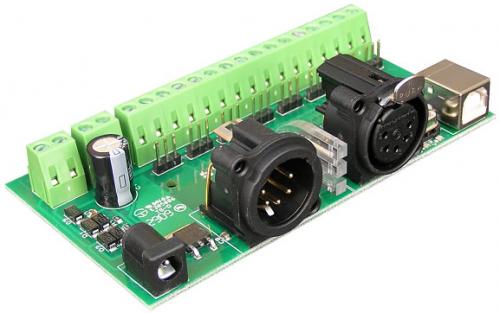
DMX-USB-RX-D8 DMX512, 8-channel Digital Output Module
Tutti i prezzi sono IVA inclusa
The DMX-USB-RX-D8 module is a fully compliant with the latest USITT DMX512-A standard, E1.11-2004. This small module, powered by a single 9V AC or DC supply, provides 8 Digital outputs. These can be a phase control output for solid state relays, pulse outputs for driving standard R/C type servo's or simple digital 5v high/low signals.
Features
Fully compliant with the latest USITT DMX512-A standard.
Backwards compatible with the older USITT DMX512/1990 standard.
Easy to use configuration via a USB port. PC application supplied, no dip switches to worry about.
Uses a single 9V AC or DC supply for power.
Module can be set to any DMX address from 1-505.
Digital output with preset thresholds from 10% to 90%
Phase Controlled Dimmer output for connection to SSR.
Servo output with a preset range of output pulse widths for R/C type servo's.
DMX feed though on all pins, including 4 & 5.
Selectable 120 Ohm termination.
Connections
Power can be connected to the module either from an 9v AC transformer to the two pin screw terminals, or from an 9v AC or DC adapter. The module cannot be powered from the USB port. The 120 ohm terminating link connects an on-board 120 ohm resistor across the DMX. This should only be fitted to the last module on the DMX cable. Remove the link on ALL other modules.

Getting Started
The default factory settings for your DMX-USB-RX-D8 module is DMX address 1 and all outputs set to 50% Threshold mode.
If this is what you need, then just connect the 9V AC or DC supply, plug in the DMX cable and your away.
It's more likely that you will want to select a different DMX address or to change the operating mode. To do this you will need a PC running Windows XP/Vista/Win7.
You will need:
The DMX_D8 Configuration program.
The USB driver for windows.
Unzip the DMX_D8 Installation file into a temporary folder and click "setup" to install it.
Next install the USB driver. If your using Vista, temporarily disconnect your internet connection by unplugging the network cable or switching off the wireless connection. This is because Vista will go off and look for a suitable driver and not offer you the chance to direct it to the correct driver. It will probably install the wrong driver. Disconnecting the internet first will force it to ask you where to look. XP is fine, it asks you anyway. Connect the 9v ac or dc supply to the module, then plug in the USB cable. Windows should detect the new module and ask for the driver. Direct windows to the "inf" folder and windows will install the driver. Once installed you will have a new serial comm. port listed in Device Manager.
Run the DMX_D8 Configuration program, and you will see the following dialog. Select the new comm. port and it will find the module and display its software revision number. The DMX address the module is currently set to is displayed.

Led Status
| Top | Green Led | DMX Good |
| Middle | Red Led | No DMX |
| Bottom | Blue Led | USB Connected |
Changing the Output Mode
Each output has its own drop down box. you can select from a variety of Dimmer/Servo and Threshold modes. If you select Dimmer mode for any output you must also supply 9VAC to the module. If you use a DC power supply, then Dimmer mode cannot work.
Servo modes provide the following pulse output ranges for a level change of 0-255:
Servo Std, 1.1mS to 1.9mS
Servo Full, 1.0mS to 2.0mS
Servo Exp1, 0.9mS to 2.1mS
Servo Exp2, 0.8mS to 2.2mS
Servo Exp3, 0.7mS to 2.3mS
The pulse is automatically repeated every 20mS.
Threshold mode with preset thresholds from 10% to 90%
Changing the DMX address
The DMX address can be set to any between 1 and 505. Just enter the new address in the "DMX Address" edit box and click the "Update" button. The 8 channels on the DMX-USB-RX-D8 module are numbered consecutively. If you select address 505, then channel Chn1 will be at address 505, channel Chn2 will be at address 506 and channel Chn8 will be at address 512.
DMX Connections
The 5-pin XLR connections follow industry standard pin-out.
| Use | 5-pin XLR Pin number | DMX512 Function |
| Common Reference | 1 | Data Link Common |
| Primary Data Link | 2 | Data 1- |
| 3 | Data 1+ | |
| Secondary Data Link (unused by module, but connected through on XLR's) |
4 | Data 2- |
| 5 | Data 2+ |
Termination
If the module is the last one on the DMX cable, you should ensure the link is fitted on the board. This will enable the 120 ohm terminating resistor.
Where the DMX is feeding through to other modules further down the cable, this link should be removed.
